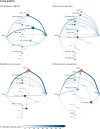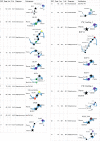Building blocks and blueprints for bacterial autolysins
- PMID: 33793553
- PMCID: PMC8051824
- DOI: 10.1371/journal.pcbi.1008889
Building blocks and blueprints for bacterial autolysins
Abstract
Bacteria utilize a wide variety of endogenous cell wall hydrolases, or autolysins, to remodel their cell walls during processes including cell division, biofilm formation, and programmed death. We here systematically investigate the composition of these enzymes in order to gain insights into their associated biological processes, potential ways to disrupt them via chemotherapeutics, and strategies by which they might be leveraged as recombinant antibacterial biotherapies. To do so, we developed LEDGOs (lytic enzyme domains grouped by organism), a pipeline to create and analyze databases of autolytic enzyme sequences, constituent domain annotations, and architectural patterns of multi-domain enzymes that integrate peptidoglycan binding and degrading functions. We applied LEDGOs to eight pathogenic bacteria, gram negatives Acinetobacter baumannii, Klebsiella pneumoniae, Neisseria gonorrhoeae, and Pseudomonas aeruginosa; and gram positives Clostridioides difficile, Enterococcus faecium, Staphylococcus aureus, and Streptococcus pneumoniae. Our analysis of the autolytic enzyme repertoires of these pathogens reveals commonalities and differences in their key domain building blocks and architectures, including correlations and preferred orders among domains in multi-domain enzymes, repetitions of homologous binding domains with potentially complementarity recognition modalities, and sequence similarity patterns indicative of potential divergence of functional specificity among related domains. We have further identified a variety of unannotated sequence regions within the lytic enzymes that may themselves contain new domains with important functions.
Conflict of interest statement
I have read the journal’s policy and the authors of this manuscript have the following competing interests: KEG and CB-K are member-managers of Lyticon LLC. No other authors have a conflict of interest. Potential conflicts of interest for KEG and CB-K are under management at Dartmouth. The authors declare that the work presented here is free of any bias.
Figures








Similar articles
-
O-Acetylated peptidoglycan: controlling the activity of bacterial autolysins and lytic enzymes of innate immune systems.Int J Biochem Cell Biol. 2011 Dec;43(12):1655-9. doi: 10.1016/j.biocel.2011.08.007. Epub 2011 Aug 24. Int J Biochem Cell Biol. 2011. PMID: 21889603 Review.
-
Surface proteins of gram-positive bacteria and mechanisms of their targeting to the cell wall envelope.Microbiol Mol Biol Rev. 1999 Mar;63(1):174-229. doi: 10.1128/MMBR.63.1.174-229.1999. Microbiol Mol Biol Rev. 1999. PMID: 10066836 Free PMC article. Review.
-
Identification of a new family of enzymes with potential O-acetylpeptidoglycan esterase activity in both Gram-positive and Gram-negative bacteria.BMC Microbiol. 2005 Aug 19;5:49. doi: 10.1186/1471-2180-5-49. BMC Microbiol. 2005. PMID: 16111493 Free PMC article.
-
The pneumococcal cell wall degrading enzymes: a modular design to create new lysins?Microb Drug Resist. 1997 Summer;3(2):199-211. doi: 10.1089/mdr.1997.3.199. Microb Drug Resist. 1997. PMID: 9185148 Review.
-
Design and characterization of a novel lytic protein against Clostridium difficile.Appl Microbiol Biotechnol. 2022 Jun;106(12):4511-4521. doi: 10.1007/s00253-022-12010-0. Epub 2022 Jun 14. Appl Microbiol Biotechnol. 2022. PMID: 35699735 Free PMC article.
Cited by
-
Agents Targeting the Bacterial Cell Wall as Tools to Combat Gram-Positive Pathogens.Molecules. 2024 Aug 27;29(17):4065. doi: 10.3390/molecules29174065. Molecules. 2024. PMID: 39274911 Free PMC article. Review.
-
Staphylococcus aureus sacculus mediates activities of M23 hydrolases.Nat Commun. 2023 Oct 23;14(1):6706. doi: 10.1038/s41467-023-42506-w. Nat Commun. 2023. PMID: 37872144 Free PMC article.
-
Influence of NaCl and pH on lysostaphin catalytic activity, cell binding, and bacteriolytic activity.Appl Microbiol Biotechnol. 2022 Oct;106(19-20):6519-6534. doi: 10.1007/s00253-022-12173-w. Epub 2022 Sep 16. Appl Microbiol Biotechnol. 2022. PMID: 36112205
-
The impact of metagenomic analysis on the discovery of novel endolysins.Appl Microbiol Biotechnol. 2025 May 24;109(1):126. doi: 10.1007/s00253-025-13513-2. Appl Microbiol Biotechnol. 2025. PMID: 40411603 Free PMC article. Review.
-
One fold, many functions-M23 family of peptidoglycan hydrolases.Front Microbiol. 2022 Oct 21;13:1036964. doi: 10.3389/fmicb.2022.1036964. eCollection 2022. Front Microbiol. 2022. PMID: 36386627 Free PMC article. Review.
References
Publication types
MeSH terms
Substances
Grants and funding
LinkOut - more resources
Full Text Sources
Other Literature Sources

